|
Meanwhile, in Leyton, Leytonstone, and Wanstead,
lest we forget that, not so long ago, they forced the M11 link
road extension through this residential haven,
destroying hundreds of houses, wrecking
the scenery, trashing nature, smashing communities. For what? Trimming
a few minutes off travel time, into a city where nowadays they want to
discourage car congestion, where nowadays they pedestrianise the roadspace
thats available, or fill it with bus and bicyle lanes.
In the early nineties, it became a reality that so much ruination would come to East London, a cruel drive of bruality through so much history and so many victorian dwellings. Unbelievable. They could have sent the M11 southwards instead, and turned right at Barking, making flyovers above the river, as in Tokyo. Instead, they crushed homes and beauty.
Wanstead Green chestnut tree, and WanstoniaWanstead was always gorgeous. It was always my haunt. A beautiful tranquil village in North East London, full of green spaces and lovely large houses, but sadly, sitting on the end of the A12 carriageway stretch, it was always well clogged with traffic. If only they would leave the traffic to be self regulating, as they always had done, instead of carving up the beauty of the area. And on that plateau was a huge chestnut tree, standing there innocently for hundreds of years, the first hurdle and barrier to the fiends that would obliterate all before them, just to get more cars into London.
 Wanstead in more peaceful times
When I heard of Wanstead's
future defacement, I was horrified. And late one night, I passed the green and
its 300 year old tree, squatted by some last stand eco-terrorists, trying
and preserve it for the future. They were in it for the long term, and all
through 1993 they kept vigil, beating off those that might devour this
emblem of preservation.
It's not often i'm alongside token lefty protests, but these chaps were doing
a brilliant job. But after months of bitter cold and baliff threats, one day
the residents and tree defenders had to watch as the age old tree was attacked
by the demolition squad. The battle for Wanstead had just begun...
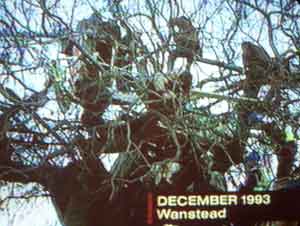
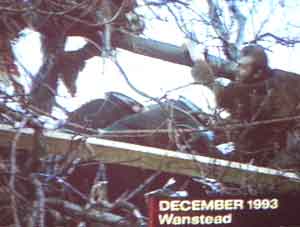
And one day, I saw the tree, lifeless on its side, leafless, scarred, torn down like rubbish, but displayed as the spoils of road war. These rotters would stop at nothing. And the same fate was bestowed upon the houses down the stretch towards Leytonstone. Lovely houses that I visited in my youth, now threatened with bulldozers, only the incumbent protesters standing in the way of immenent destruction. It was a fun novelty of theirs to declare independence as the 'Free state of Wanstonia', but there wasnt much chance of recognition. Soon, they too were gone. Miles of property flattened, fenced off, and guarded by cameras, lights and guards. It was an amazing sight. Unlimited funding for the perpetrators of evil. Attention moved to the next phase, Leyton. Claremont Road, Dolly Watson, Dolly's Tower.I heard the rumours of Claremont Road and took to visit one sunny summers day. So wonderful and quiet was she, in spite of being between the tube line and one of Leyton's major roads. What a fantastic place, a little haven, a cute London street. A retreat of peace and quiet.
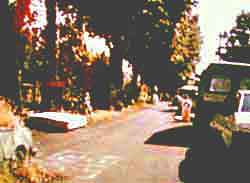 Claremont: My first visit, June '94 A happy community spirit Claremont Road was so amazingly tranquil and happy. A long street of some 30 Victorian houses, tree lined one one side, houses on the other, these now all squatted and wildly decorated in psychedelic art, except for one house, still the domain of the sweet 93 years young Dolly, looking on in bemusement at her new friends and would-be saviours.
 Dearest Dolly Watson of Claremont Dolly had been there most of her life, and wouldnt give up like her former neighbours, but i'm sure she shared the gloom and inevitability like everyone else, that one day it would all die. And by this time, the road was well bookmarked for death, and official maps saw the M11 road now running right through it. Its new inhabitants were delighting in the pleasures that only victorian street design could provide. Protesters? Maybe. But this road deserved to live. And these people deserved a home. And at this moment they were the life of Claremont. And this was such a refuge of utter beauty.
 My second visit to Claremont August '94: The Rust In Peace car. Claremont at that time was so funny. Not outrageous or loud or ghastly, but just fun and enormously happy. A big friendly commune of welcome and greeting. Just like London used to be, but maybe with it's eccentric and creative overtones. Sofas and chairs in the street, a no-car zone apart from the street's very own green 'Rust in Peace' car, full of art and flowers. A cafe, an office, and a thriving little community, all asking me for "Any spare change". Busking in the sunshine, dogs yapping, the breeze in the trees, and artistic happenings aplenty. It was a very dynamic and yet meditative atmos. I may not be a tattooed punk, but I loved it there.
The end of the world is HighOf course, the inhabitants of Claremont were on borrowed time, and in the final months the road was a small island in the middle of miles of bulldozered land and building sites, all cordoned off and protected by security mobsters. It was a strange place to visit then, and you could feel the threat from the outside world, and the fear in the camp, and the misery that this backsteet of Leyton was doomed for no reasons. No-one there knew when death would come, but it would surely come.
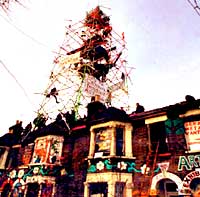
And it was a long slow death, over weeks and weeks as the community carried on, now surrounded by government barracades and fences. On future visits, I saw the entourage slowly erect a 100 ft scaffold, named 'Dolly's Tower' above the houses. A huge undertaking and freedom symbol that could be seen for miles.
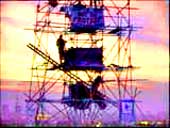
This, and a number of ingenious contraptions, would help defenders
in a final fight, which came, months later, one sad and early morning, when
government took its revenge on the settlement.
This was thier finest hourI often passed Claremont on the tube, it always looked serene, like something untouchable. But that day, I passed by in shock, as the road was filled with 100's of riot police, and the Crusties had taken to the rooftops. I guess Dolly must have taken cover, I couldnt see her aloft. And so the siege began. It took some days to extricate the heroes from Claremont, as one by one, the houses were taken, and tired crusaders took the the scaffolding, only to be picked off by high flying baliffs and police using cranes and cherry pickers. It was an amazing last stand, and I loved it. The point was being made that houses and communities should not be threatened or destroyed, at least not without a fight. I was proud of those protesters, as they were led away from the site by brutal bouncers.
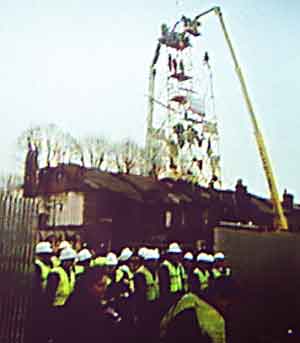
This was big news for London. Very rarely had anywhere so central to the capital been up for attack by the roadbuilders. Now Londoners could see what the countryside people had suffered. Residents backed the protesters, and a media outcry was on. Why should these roadbuilders be allowed to devastate London? Why should lovely houses be wiped out just for some extra tarmac?
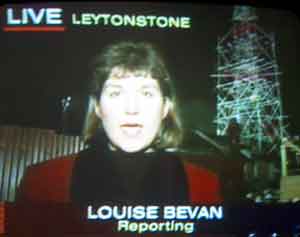
I made my last visit one freezing night in December 1994, as crowds gathered to watch the final man atop Dolly's Tower. It must have been so cold, but we all kept shouting in encouragement. There were protesters, residents, riot police, and plenty of press. Occasionally our last man waved at us and his security guard audience, only his presence keeping Claremont Road intact. I discreetly videoed the proceedings, whilst the constabulary videoed me doing it. Was I an urban terrorist?

Evidently it was a £2million operation to take him alive, and indeed they did, as the poor man could go on no more. He seemed quite well, considering. And Dolly's Tower remained for a while, lit up in the spotlights. Conquered, but a shining monument to the cause. If only it could remain like this, but I guess the dream was over.

The next time I passed, it was all gone. In a non stop performance and show of might, they had flattened all evidence of community as fast as they could. Now, just another empty section of fenced-off wasteland. Only ghosts and memories. And this was a similar but slightly less epic fate with other roads in the 3 mile demolition stretch down from Wanstead. All of 350 perfect homes, their gardens, and cute backstreets. Wiped out. Watch my Claremont Road MovieOn that cold night, my cheap and cheerless camcorder captured the sights and sounds of Claremont's last stand. Why were those Riot Police filming me doing it? Oh dear... It was worth it to see the might of government conquor at all costs. The protest never stood a chance, did it?
London Destruction's Claremont Road Movie What's in it for me?Why write a piece on active protest? Even though its natural for me to indulge in futile letter writing, only to see London destroyed and unprotected, I must admit that it was good to see campaigers fight for a cause that I agreed with. But how far does one go, when a government acts so insanely? It's a puzzlement, one that's haunted me. At least with this website, I might at least inspire the world to make things better. But with the M11 protest movement, I saw actions speaking louder than text, even though the motivations may have been more anarchistical than conservational. Ultimately, though, it was the London landscape that really suffered. Although the Motorway ended up in tunnels and sunken trenches, it looks awful. What a mess they've made, just like the mess they've made all over London, and the mess they continue to make. And so the battle goes on. But something rotten took the state of Wanstonia.Charles (of London Town)
The London Destruction Website. |